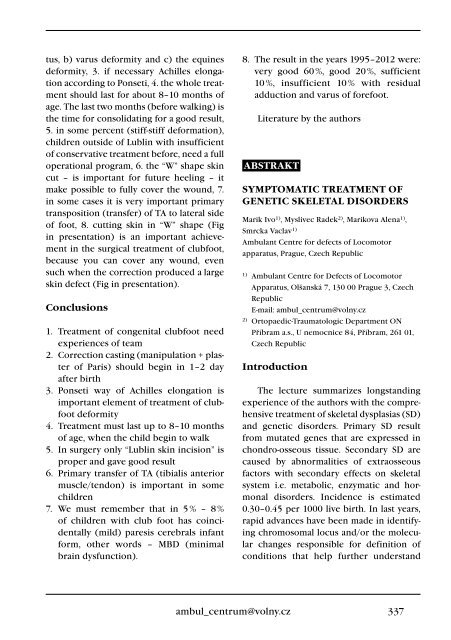3+4+Supplementum/2012 - Společnost pro pojivové tkáně
3+4+Supplementum/2012 - Společnost pro pojivové tkáně
3+4+Supplementum/2012 - Společnost pro pojivové tkáně
- TAGS
- www.pojivo.cz
You also want an ePaper? Increase the reach of your titles
YUMPU automatically turns print PDFs into web optimized ePapers that Google loves.
tus, b) varus deformity and c) the equines<br />
deformity, 3. if necessary Achilles elongation<br />
according to Ponseti, 4. the whole treatment<br />
should last for about 8–10 months of<br />
age. The last two months (before walking) is<br />
the time for consolidating for a good result,<br />
5. in some percent (stiff-stiff deformation),<br />
children outside of Lublin with insufficient<br />
of conservative treatment before, need a full<br />
operational <strong>pro</strong>gram, 6. the “W” shape skin<br />
cut – is important for future heeling – it<br />
make possible to fully cover the wound, 7.<br />
in some cases it is very important primary<br />
transposition (transfer) of TA to lateral side<br />
of foot, 8. cutting skin in “W” shape (Fig<br />
in presentation) is an important achievement<br />
in the surgical treatment of clubfoot,<br />
because you can cover any wound, even<br />
such when the correction <strong>pro</strong>duced a large<br />
skin defect (Fig in presentation).<br />
Conclusions<br />
1. Treatment of congenital clubfoot need<br />
experiences of team<br />
2. Correction casting (manipulation + plaster<br />
of Paris) should begin in 1–2 day<br />
after birth<br />
3. Ponseti way of Achilles elongation is<br />
important element of treatment of clubfoot<br />
deformity<br />
4. Treatment must last up to 8–10 months<br />
of age, when the child begin to walk<br />
5. In surgery only “Lublin skin incision” is<br />
<strong>pro</strong>per and gave good result<br />
6. Primary transfer of TA (tibialis anterior<br />
muscle/tendon) is important in some<br />
children<br />
7. We must remember that in 5 % – 8 %<br />
of children with club foot has coincidentally<br />
(mild) paresis cerebrals infant<br />
form, other words – MBD (minimal<br />
brain dysfunction).<br />
ambul_centrum@volny.cz<br />
8. The result in the years 1995–<strong>2012</strong> were:<br />
very good 60 %, good 20 %, sufficient<br />
10 %, insufficient 10 % with residual<br />
adduction and varus of forefoot.<br />
Literature by the authors<br />
aBSTRakT<br />
SYMPTOMaTiC TReaTMenT Of<br />
GeneTiC SkeleTal diSORdeRS<br />
Marik Ivo1) , Myslivec Radek2) , Marikova Alena1) ,<br />
Smrcka Vaclav1) Ambulant Centre for defects of Locomotor<br />
apparatus, Prague, Czech Republic<br />
1) Ambulant Centre for Defects of Locomotor<br />
Apparatus, Olšanská 7, 130 00 Prague 3, Czech<br />
Republic<br />
E-mail: ambul_centrum@volny.cz<br />
2) Ortopaedic-Traumatologic Department ON<br />
Příbram a.s., U nemocnice 84, Příbram, 261 01,<br />
Czech Republic<br />
introduction<br />
The lecture summarizes longstanding<br />
experience of the authors with the comprehensive<br />
treatment of skeletal dysplasias (SD)<br />
and genetic disorders. Primary SD result<br />
from mutated genes that are expressed in<br />
chondro-osseous tissue. Secondary SD are<br />
caused by abnormalities of extraosseous<br />
factors with secondary effects on skeletal<br />
system i.e. metabolic, enzymatic and hormonal<br />
disorders. Incidence is estimated<br />
0.30–0.45 per 1000 live birth. In last years,<br />
rapid advances have been made in identifying<br />
chromosomal locus and/or the molecular<br />
changes responsible for definition of<br />
conditions that help further understand<br />
337

















